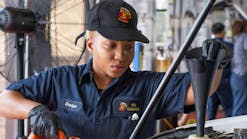So much work goes into launching a business. When the doors finally open to a new shop, operators have to get to work again to establish and grow the brand. That’s at the heart of the customer relationship—both the first impression for the business and the core of ongoing retention.
That was where the Fast Lube Plus team found itself upon its grand opening in 1999 in Cary, N.C.
The Benza family has since grown Fast Lube Plus into the six-location network it is today. They found success in the greater Raleigh market, which is the third-quickest-growing metro area in the country.
The success of Fast Lube Plus caught the attention of FullSpeed Automotive, which acquired the chain in 2018 and opted to keep the shops’ strong brand in place.
“I’ve stayed on board with them, continued to run six stores,” says Joe Benza, who ran the chain and is now the vice president of retail operations for the eastern region. “It’s a good market. It’s a competitive market, because when you look on a national scale, people want to live here.”
The core goal for marketing growth is the same now as it was in 1999. Get the business in front of customers so that they notice a valuable brand. A lot has changed with how businesses reach that goal, but Benza explains how his approach in 1999 brought success— and what he would do differently today.
The Challenge
The very first Fast Lube Plus location was a freshly constructed building, but it was in a tough spot for drive-by traffic. It sat at the end of a large commercial lot, set back a bit from the main road.
But they knew the overall area was popular. Working through the oil company’s supply agreement, they were able to get traffic surveys and local demographic information to help them choose the right site. All that prep work was done; the building was ready.
At that time, it was do or die.
“When you do a new ground-up build, there’s a time when there’s no cash flow,” Benza says. “So, you're just building your business. You're trying to grow your brand. We did not have a website. We didn't do email blasts.”
The shop had a couple feathers in its cap. First, it had a car wash attached, which could help attract customers who want a one-stop car care location. Secondly, the new building had a fresh look that really helped retain people once they experienced the shop.
“For us, we did have a new building, which was nice,” Benza says. “People would come in and comment on how clean the shop looked. So, we had great curb appeal.”
And the shop had little competition in the immediate area at first. That would change. The growth of Fast Lube Plus wouldn’t happen in a vacuum. It took place as the market grew and more competitors moved into the area.
The Solutions
Millennium Marketing
Coming into the 2000s, Fast Lube Plus worked to get its name out there the old fashioned way without the web and social media tools that exist today. And they had a tight budget.
“The challenge was just being patient and making sure that we ran the business as tight as we could,” Benza says. “It was going to be at least a year before we really start putting money back into the business with marketing and advertising, stuff like that.”
They started with some direct mail campaigns, sending out postcards and taking ads out in the local municipal magazine. Benza says they also held some customer appreciation days to help get their name out with people.
Given the chance to restart a business today, he says those tactics can be just as effective now as they were in the 2000s. Postcard mailers are still great tools for customer retention and keeping that line of contact with people.
Another outreach tool that hasn’t gone away is the power of media attention, because the right story placement with a local news outlet will distribute your shop’s name for you.
“The best type of advertising is PR,” Benza says. “So, if you have a way to get in touch with local newspapers or local news channels, do a grand opening event. Do free oil changes for a weekend or something. Get some kind of notoriety in the press, even if it’s a little blurb.”
When the strategies began paying off, Fast Lube Plus was able to put a little money back into the business and grew through acquisitions. As the shops evolved, so did the means of customer outreach.
Websites and Beyond
Of course, there are new tools that businesses have that weren’t available in 1999. The strategies above would still largely apply, but now the digital space is where most customers interact.
“What we would do today would be really work the social media angles,” he says. “Make sure you have a strong presence on your search engine optimization, and a lot of that is through constant blogging through your website.”
Maintaining regular blog items on a website helps Google to recognize your business as active and in good standing, which is reflected in search results when someone types in “oil changes near me.” Another key to getting those drivers into the shop is kindly asking existing customers to leave a review.
“You have to maintain your online reputation,” Benza says. “If I’m building a ground-up tomorrow, I’m asking friends, family, customers, ‘Everybody to please give us a Google review,’ so people see that we have a 4.5 or a five-start rating.”
More consumers are checking those ratings before pointing their GPS app toward your shop. High ratings, especially paired with real customer reviews, go a long way to attract new business.
The Aftermath
Branding through marketing offers a business a bit of control over their approach and budget. But sometimes, growing a network in a competitive market requires operators to be quick on their feet.
Fast Lube Plus got into its second location just four years after launching its first. That’s because a competitor moved in just about a mile away. Benza says its numbers weren’t stellar, but they still made a deal to acquire when the opportunity came up. It was a strategic move.
“What we were trying to prevent was somebody going in there and running a good business and taking from ours, so we kind of cornered that market,” he says.
The shop operated at a lower volume than what Fast Lube Plus was used to, but Benza says that it proved to be a valuable acquisition.
And that became more important as the Raleigh area grew. Other franchises continued to move into the area, and Fast Lube Plus tweaked its business model a bit to boost ticket averages as car counts slowed.
“We’ve evolved over time from a traditional quick lube to bringing in repairs and starting to do brakes and tuneups and A/C recharges and things that we used to not do,” he says.
The science of growth has a lot of different factors, but having a strong brand in place means that all shops in the network are able to support one another. It might mean gaining some purchasing power with distributors through added volume, or it could mean getting the attention of a new group of customers by having more real estate around town.
Fast Lube Plus gained scale with the addition of its second location, as well as the subsequent four. Each shop has its own numbers, but they’re all working toward the same goal.
“You’re gonna have some lower performers, but that helps you in more ways than you realize in the beginning,” Benza says. “You’re not losing customers to the competition. You’re not losing employees to nearby competition. You're adding gallons to your total portfolio.”
The Takeaway
A lot has changed in the marketing realm. Online tools have changed the way shops reach customers, but physical marketplaces have become more crowded as well. There’s more competition around in most areas.
For shops looking to boost their community profile, social media is a great and low-cost place to start. That’s where the customers are.
But don’t discount the tried and true strategies that have helped businesses for years. Where social media might help get attention, a mailer or physical gift might be a more personal way to reach out to existing customers and build relationships. As Benza mentioned, postcard mailers are one way they still shore up customer retention.
There are so many ways that businesses need to be adaptive. That means taking on new challenges, but it also means integrating strategies that have always worked.






